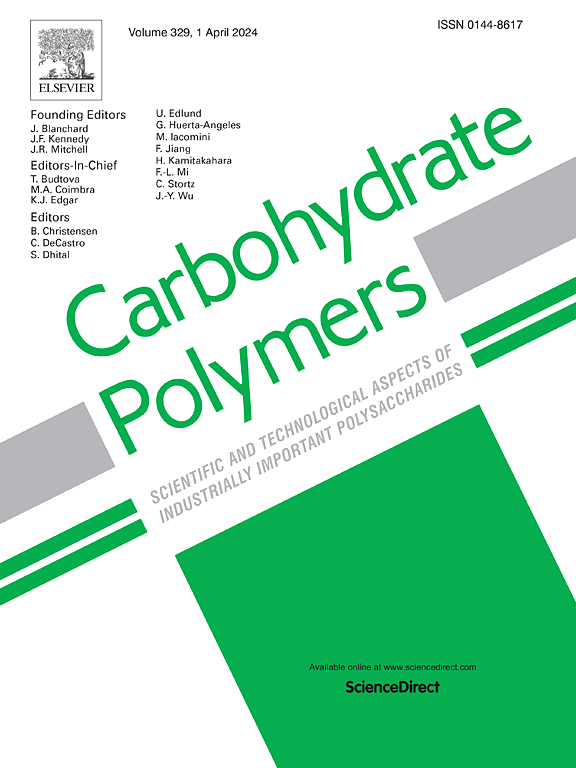Anti-inflammatory and antioxidant succinyl-chitosan oligosaccharide protects human epidermal cell and mouse skin against ultraviolet B-induced photodamage
IF 12.5
1区 化学
Q1 CHEMISTRY, APPLIED
引用次数: 0
Abstract
Ultraviolet B (UVB) irradiation from sunlight is one of the primary environmental factors that causes photodamage to the skin. The aim of this study was to prepare succinyl-chitosan oligosaccharide (SU-COS) and evaluate its protective effects and related molecular mechanisms against UVB-induced photodamage for the first time. SU-COS (substitution degree: 69.26 %, molecular weight: 6400 Da) was shown to have excellent biocompatibility and to effectively promote the migration of human epidermal HaCaT cells. UVB irradiation was used to develop photodamage models in HaCaT cells and murine skin. In vitro, treatment with SU-COS significantly increased the cell survival ratio by >11 % while concurrently reducing reactive oxygen species formation, preserving normal cytoskeletal morphology, stabilizing the cell cycle, and decreasing the apoptosis ratio. The SU-COS intervention also demonstrated a reparative effect on UVB-damaged mouse skin by reducing skin erythema and water loss, relieving crusting, and maintaining the epidermis thickness of the skin and the stability of collagen fibers. The observed changes in both in vitro and in vivo results were accompanied by significant modulation of gene and protein expression associated with the cellular cycle, collagen synthesis, extracellular matrix degradation, antioxidant defense, and inflammation. Overall, SU-COS holds immense promise for applications in repairing photodamage.

抗炎抗氧化琥珀酰壳聚糖对人表皮细胞和小鼠皮肤抗紫外线b光损伤具有保护作用。
来自阳光的紫外线B (UVB)照射是导致皮肤光损伤的主要环境因素之一。本研究首次制备了琥珀酰壳聚糖(suinyl -chitosan oligosaccharide, SU-COS),并对其抗uvb光损伤的保护作用及其分子机制进行了初步研究。SU-COS(取代度:69.26%,分子量:6400 Da)具有良好的生物相容性,能有效促进人表皮HaCaT细胞的迁移。采用UVB照射建立HaCaT细胞和小鼠皮肤光损伤模型。在体外,SU-COS处理可显著提高细胞存活率(约11%),同时减少活性氧的形成,保持正常的细胞骨架形态,稳定细胞周期,降低凋亡率。SU-COS干预也显示出对uvb损伤小鼠皮肤的修复作用,通过减少皮肤红斑和水分流失,缓解结痂,维持皮肤表皮厚度和胶原纤维的稳定性。在体外和体内观察到的变化伴随着与细胞周期、胶原合成、细胞外基质降解、抗氧化防御和炎症相关的基因和蛋白质表达的显著调节。总之,SU-COS在修复光损伤方面有着巨大的应用前景。
本文章由计算机程序翻译,如有差异,请以英文原文为准。
求助全文
约1分钟内获得全文
求助全文
来源期刊

Carbohydrate Polymers
化学-高分子科学
CiteScore
22.40
自引率
8.00%
发文量
1286
审稿时长
47 days
期刊介绍:
Carbohydrate Polymers stands as a prominent journal in the glycoscience field, dedicated to exploring and harnessing the potential of polysaccharides with applications spanning bioenergy, bioplastics, biomaterials, biorefining, chemistry, drug delivery, food, health, nanotechnology, packaging, paper, pharmaceuticals, medicine, oil recovery, textiles, tissue engineering, wood, and various aspects of glycoscience.
The journal emphasizes the central role of well-characterized carbohydrate polymers, highlighting their significance as the primary focus rather than a peripheral topic. Each paper must prominently feature at least one named carbohydrate polymer, evident in both citation and title, with a commitment to innovative research that advances scientific knowledge.
 求助内容:
求助内容: 应助结果提醒方式:
应助结果提醒方式:


